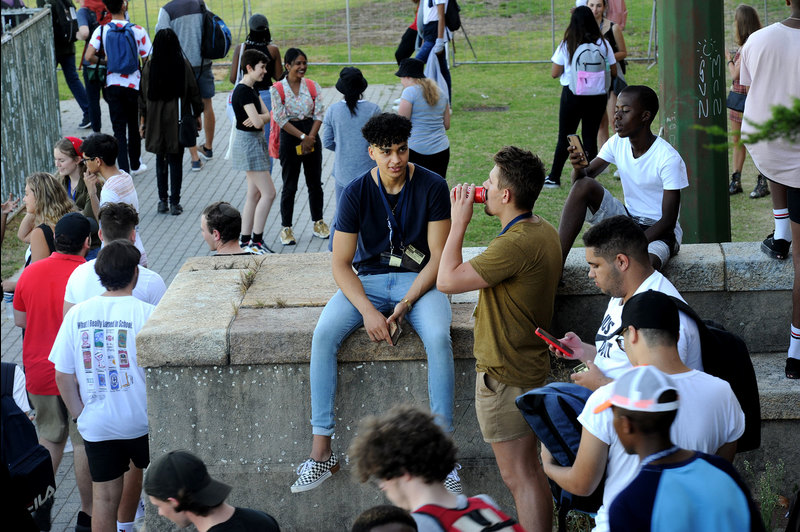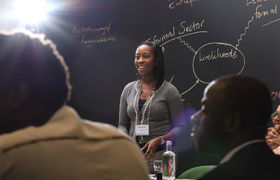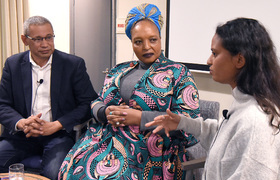GSB partnership focuses on youth development
10 March 2020 | Story Supplied. Photo Lerato Maduna. Read time 6 min.
The Bertha Centre for Social Innovation and Entrepreneurship at the University of Cape Town (UCT) Graduate School of Business (GSB) and youth development lab Lucha Lunako have teamed up to find practical and actionable ways to get young South Africans economically active.
Dubbed the Youth Innovation Partnership, the project seeks to provide fresh impetus to those working in the youth development space and better support young South Africans who are battling to access work and other opportunities.
Approximately 8.2 million (40.1%) of South Africa’s 20.4 million young people aged 15 to 34 are not in employment, education or training of any sort, according to the latest figures released by Statistics South Africa in the Quarterly Labour Force Survey. In his State of the Nation Address 2020, President Cyril Ramaphosa called this a national crisis.
“We want to build an ecosystem of innovation that supports a young person’s transition from education to employment.”
The partnership, which kicked off with a workshop at the GSB Solution Space in Philippi, Cape Town, last week, aims to surface existing strategies that are successfully addressing these challenges and to build these out into a collaborative youth development framework that is practical and actionable.
“We want to build an ecosystem of innovation that supports a young person’s transition from education to employment,” said Solange Rosa, interim director of the Bertha Centre.
“This is a perfect opportunity to look at where the gaps are and to identify how to develop a network of support that is collaborative and will spearhead more innovative responses.”
A different approach
Alana Bond, co-founder of Lucha Lunako (which means “the youth have it”) said the partnership would focus on “what it actually takes to get young people economically active” – which might include self-employment. A top priority is addressing the issue of “churn” or job insecurity.
A recent study by the Harambee Youth Employment Accelerator found that typically only one in five job seekers secure work that lasts longer than three months. An additional one in four find erratic work lasting less than three months.
Employee income tax data submitted to the South African Revenue Service similarly show that only half of annually registered jobs are stable from one year to the next.
“Effective interventions must be more inclusive and diverse.”
Bond explained that they had observed hundreds of young people over the past few years access development opportunities yet remain ill-equipped for employment.
Having employed a number of youth in entry-level opportunities over the same period, “we started with our observation that young people lack sufficiently developed foundations to absorb and utilise the technical and workplace readiness training they receive”, she said.
“With so much focus and money in South Africa going into [Sector Education and Training Authority] SETA-accredited learnerships and other qualifications, as well as workplace readiness, we are concerned about the lack of impact for the money spent, and want to propose a different approach to youth development.
“In addition to this, we want to develop guiding principles for any organisations working in the youth development space, and make a number of other broad recommendations for the youth sector, with a key focus on collaboration.”
Collaboration is key
According to Simnikiwe Xanga, programme liaison officer at the GSB Solution Space, the key collaborators in this process are the youth themselves. The Cape Town workshop included a moderated panel discussion on understanding individual perspectives and the lived experience of local youth.
“Too often decisions about youth development are made by older men typically working in patriarchal structures such as government. A clear message from the young voices at our workshop was that effective interventions must be more inclusive and diverse,” she said.
“Youth urgently need spaces where they can access opportunities and resources that help them find stable formal employment or self-employment. And if these are not available, we need to create and occupy them ourselves.”
The workshop included a discussion on innovation in the sector with participants presenting their approaches, models, rationale and calls to action for effective youth development.
These included the interactive Youth Explorer tool from the Southern African Labour and Development Research Unit, based in the School of Economics at UCT, and Youth Capital, a campaign that strives to transform the employment trajectory of a generation of young South Africans, led by the DG Murray Trust, also presented their framework.
Moving forward
The action moves to Johannesburg this week where a second workshop will take place at Impact Hub in Rosebank on Wednesday, 11 March. Thereafter, participants will continue to engage through a series of webinars to further plot the shape, size and trajectory of the partnership.
“We envision a world where youth use their agency and skills to access sustainable and decent work, with the ability to build aspirational careers,” said Nizenande Machi of Lucha Lunako.
“These youth have the basic mental, emotional, psychosocial and competency tools to transcend the often traumatic conditions of their upbringing and we just need to provide them with support to develop themselves into active citizens who participate in the economic activities of a nation, and address poverty and inequality.”
 This work is licensed under a Creative Commons Attribution-NoDerivatives 4.0 International License.
This work is licensed under a Creative Commons Attribution-NoDerivatives 4.0 International License.
Please view the republishing articles page for more information.










